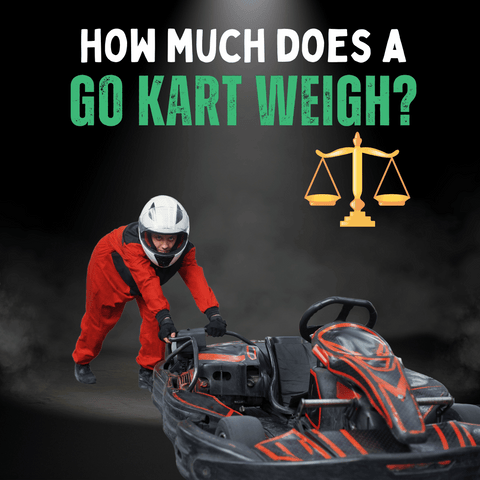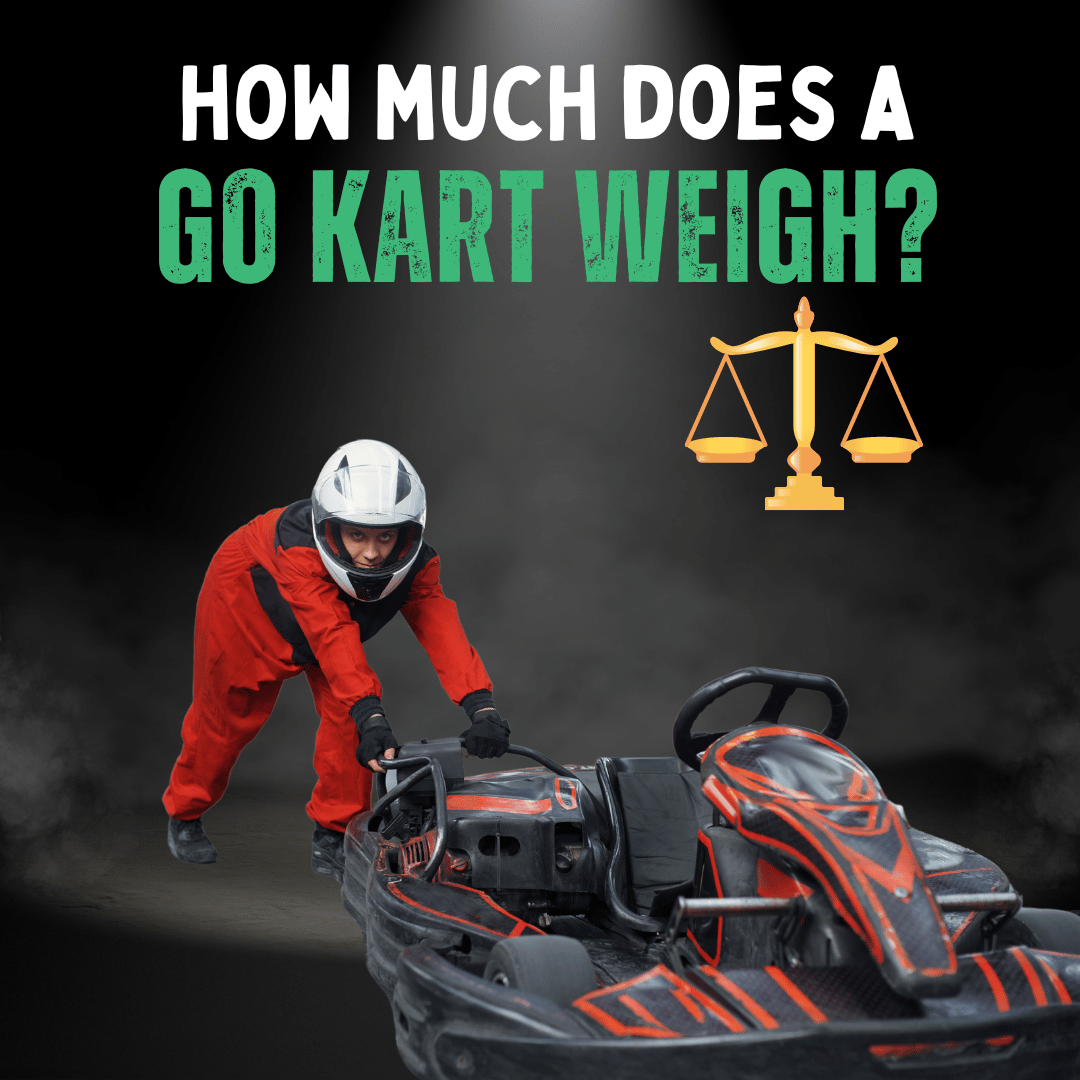Updated: 13.3.25
Have you ever wondered about the weight of a racing go-kart? If so, you're not alone.
You might be curious about how much an electric go-kart weighs, or perhaps you're interested in knowing if there's a weight limit for go-karting. 
Understanding the weight of a racing go-kart is fundamental to the sport, affecting everything from speed to control.
With this in mind, does body weight matter in go-karts?
With a mixture of curiosity and a dash of technicality, we're about to delve into the world of go-kart weights.
How Much Does a Racing Go-Kart Weigh?
A racing go-kart, designed for professional competitions, typically carries a weight ranging from 165 to 175 pounds (approximately 75 to 79 kilograms). This weight specification refers to the complete kart, excluding the driver. These karts are engineered with an emphasis on speed and maneuverability, hence their weight plays a significant role in achieving these goals. But, have you ever wondered will I fit in a go-kart based on my own body weight? It's crucial to note that the weight of a go-kart can vary based on the specific design, materials used, and the inclusion of any additional features or enhancements.
Remember, always keep it within the racing regulations to maintain fair play.
Speed, handling, and the ability to maneuver your kart around the track all play significant roles, but it's essential to consider whether the fastest go-kart is the right choice for you.
Factors Influencing the Weight of a Racing Go-Kart
Kart Class and Age
The weight of a racing go-kart largely depends on its class and age.
There are multiple go-kart categories, each with different weight criteria.
The senior kart, for instance, will weigh differently from a junior kart.
Similarly, an older model kart might weigh more due to outdated components or added weight over time.
Driver Inclusion
When speaking about kart weights, it's important to understand that some measurements include the driver, while others don't.
As you can imagine, a go-kart driver will significantly increase the overall weight, affecting the kart's performance on the track.
Presence of Fuel
Fuel is another factor that can add a considerable load to the kart.
With one gallon of fuel weighing around 6 pounds, a fully fuelled go-kart can weigh significantly more than one without any fuel.
Estimated Weights of Various Racing Go-Karts

The weight of racing go-karts can vary quite a bit. On average, a kart weighs between 150 to 175 pounds (without the driver).
In the race-ready state, this weight ranges between 165-175 pounds.
More professional racing karts, such as those used in sprint races or endurance races, can weigh anywhere between 99 lbs and 319 lbs without the driver.
Differences in Weight between Rental Karts and Racing Go-Karts
Rental karts, often available at local karting tracks for public use, typically weigh more than professional racing go-karts.
This added weight, which often comes from safety features like bumpers and seatbelts, helps make them more durable and safer for inexperienced drivers.
The Role of Weight in Go-Kart Racing
Weight Requirements and Regulations
In professional racing, there are specific weight requirements that must be met.
If the combined weight of the kart and driver falls short, lead weights may need to be bolted onto the kart to meet the regulations.
The Impact of Weight on Kart Performance
It might seem like a lighter kart would be better for speed, but in racing, the kart's weight can play a crucial role in its handling and stability.
A heavier kart tends to be more stable around the corners, making it an essential factor in karting strategy.
Effect of Weight in Different Racing Conditions
Indoor Track vs Outdoor Track
The weight of a go-kart may have varying implications depending on whether you're racing on an indoor track or an outdoor track.
For example, a heavier kart might perform better on outdoor tracks where wind resistance and varied terrain come into play.
In contrast, a lighter kart may be preferred for indoor tracks where sharp turns and shorter straights are common.
How to Adjust Weight for Optimised Performance
Adjusting the weight of a racing go-kart is a common practice for professional drivers.
This might involve adding lead weights to certain areas of the kart to improve its balance and handling, especially during sprint races or endurance races.
Remember, always keep it within the racing regulations to maintain fair play.
The Effect of Engine Type on Kart Weight
2-Stroke Engines
The 2-stroke karts, also known as 2T or two-stroke karts, are typically lighter than their 4-stroke counterparts.
But, if speed is a priority, you might be wondering are electric go-karts faster than petrol?
This is because they have a simpler engine design, which contributes less to the overall mass.
4-Stroke Engines
On the other hand, 4-stroke karts, also known as 4T or four-stroke karts, have a more complex engine design, which typically adds more weight to the kart.
However, they offer better fuel efficiency and torque, making them a common choice for certain categories of karting.
Conclusion
Grasping the weight of a professional racing go-kart, typically between 165 to 175 pounds (or 75 to 79 kilograms) without the driver, is vital in comprehending the complexities of kart racing.
Numerous elements contribute to this weight, including the kart's class, the driver's weight, and the engine type.
When engaging in karting, remember, the weight of your kart is a significant factor impacting your control and performance on the track.
It's not solely about speed but how effectively you can manage the weight of your kart during the race.
FAQs
What is the ideal weight distribution for a racing go-kart?
The optimal weight distribution for a racing go-kart generally leans towards 43% at the front and 57% at the rear, with a 50/50% balance from side to side. This setup can be fine-tuned using tools like a Sniper laser. Additionally, the kart's ride height should be lower at the front and higher at the rear for optimal performance.
Does the type of fuel used affect the weight of a racing go-kart?
Yes, the type of fuel used can affect the weight of a racing go-kart. Different fuels have different densities, which can slightly alter the kart's weight. However, this change is usually minimal and typically does not have a significant impact on performance.
Are there specific weight considerations for electric go-karts?
Weight considerations for electric go-karts can vary, just like standard go-karts. They often have an average weight limit situated between 160 to 170 pounds, approximately 72 to 77 kilograms. However, specifics can differ based on the model and regulations of the racing event.
Get in Touch
Hey there, speed enthusiast!
We hope this article put some oomph into your go-kart knowledge.
But if you're still revving your engine with questions, we're here to help!
Perhaps you want to learn more about the fast world of go-karts or maybe you're interested in other kid's ride-on toys.
Whatever it is, we at RiiRoo are ready to race to your aid!
Just hop onto our website and let's keep the conversation going.
If you're more of a chat person, you can catch us on Live Chat.
We promise to make it more fun than a spin on the track!
Stay fast, stay curious, and always remember – the track is yours!







Share:
How To Drive A Go Kart In The Wet
Are Ride On Toys Good For Toddlers?